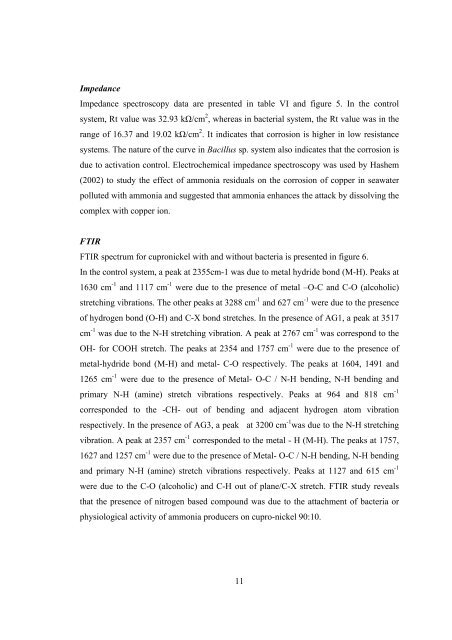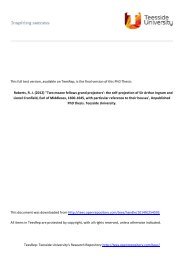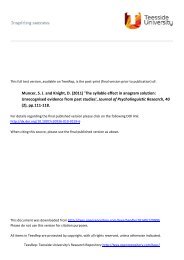Maruthamuthu, S. et al. - Teesside's Research Repository
Maruthamuthu, S. et al. - Teesside's Research Repository
Maruthamuthu, S. et al. - Teesside's Research Repository
Create successful ePaper yourself
Turn your PDF publications into a flip-book with our unique Google optimized e-Paper software.
Impedance<br />
Impedance spectroscopy data are presented in table VI and figure 5. In the control<br />
system, Rt v<strong>al</strong>ue was 32.93 kΩ/cm 2 , whereas in bacteri<strong>al</strong> system, the Rt v<strong>al</strong>ue was in the<br />
range of 16.37 and 19.02 kΩ/cm 2 . It indicates that corrosion is higher in low resistance<br />
systems. The nature of the curve in Bacillus sp. system <strong>al</strong>so indicates that the corrosion is<br />
due to activation control. Electrochemic<strong>al</strong> impedance spectroscopy was used by Hashem<br />
(2002) to study the effect of ammonia residu<strong>al</strong>s on the corrosion of copper in seawater<br />
polluted with ammonia and suggested that ammonia enhances the attack by dissolving the<br />
complex with copper ion.<br />
FTIR<br />
FTIR spectrum for cupronickel with and without bacteria is presented in figure 6.<br />
In the control system, a peak at 2355cm-1 was due to m<strong>et</strong><strong>al</strong> hydride bond (M-H). Peaks at<br />
1630 cm -1 and 1117 cm -1 were due to the presence of m<strong>et</strong><strong>al</strong> –O-C and C-O (<strong>al</strong>coholic)<br />
str<strong>et</strong>ching vibrations. The other peaks at 3288 cm -1 and 627 cm -1 were due to the presence<br />
of hydrogen bond (O-H) and C-X bond str<strong>et</strong>ches. In the presence of AG1, a peak at 3517<br />
cm -1 was due to the N-H str<strong>et</strong>ching vibration. A peak at 2767 cm -1 was correspond to the<br />
OH- for COOH str<strong>et</strong>ch. The peaks at 2354 and 1757 cm -1 were due to the presence of<br />
m<strong>et</strong><strong>al</strong>-hydride bond (M-H) and m<strong>et</strong><strong>al</strong>- C-O respectively. The peaks at 1604, 1491 and<br />
1265 cm -1 were due to the presence of M<strong>et</strong><strong>al</strong>- O-C / N-H bending, N-H bending and<br />
primary N-H (amine) str<strong>et</strong>ch vibrations respectively. Peaks at 964 and 818 cm -1<br />
corresponded to the -CH- out of bending and adjacent hydrogen atom vibration<br />
respectively. In the presence of AG3, a peak at 3200 cm -1 was due to the N-H str<strong>et</strong>ching<br />
vibration. A peak at 2357 cm -1 corresponded to the m<strong>et</strong><strong>al</strong> - H (M-H). The peaks at 1757,<br />
1627 and 1257 cm -1 were due to the presence of M<strong>et</strong><strong>al</strong>- O-C / N-H bending, N-H bending<br />
and primary N-H (amine) str<strong>et</strong>ch vibrations respectively. Peaks at 1127 and 615 cm -1<br />
were due to the C-O (<strong>al</strong>coholic) and C-H out of plane/C-X str<strong>et</strong>ch. FTIR study reve<strong>al</strong>s<br />
that the presence of nitrogen based compound was due to the attachment of bacteria or<br />
physiologic<strong>al</strong> activity of ammonia producers on cupro-nickel 90:10.<br />
11





